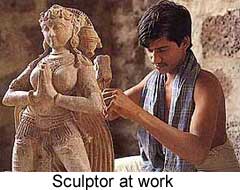The British, who ruled parts of India from 1757 to 1947, introduced new styles of art and architecture. Until the mid-1800's, Indian sculptors worked in the Western classical style on British government buildings. In the late 1800's and early 1900's, a style known as Indo-Saracenic was developed. The basic design was Western, but incorporated such Indian features as domes, kiosks, and finely carved stonework.
 In India today, there are sculptors working in Gujarat, Rajasthan, Tamil Nadu, and elsewhere who trace their families back to the great temple builders of the past. They continue to decorate temples with sculpture using traditional methods. Other sculptors produce works which exhibit the methods, materials, and outlook of the present day, while retaining an Indian identity.
In India today, there are sculptors working in Gujarat, Rajasthan, Tamil Nadu, and elsewhere who trace their families back to the great temple builders of the past. They continue to decorate temples with sculpture using traditional methods. Other sculptors produce works which exhibit the methods, materials, and outlook of the present day, while retaining an Indian identity.
Exposed to stimuli all over the world, Indian sculptors today are experimenting in all styles, using new materials like steel and aluminium, fibre-glass and even fibre. But the most significant trend seems to be the one which seems to recover the iconic quality, the power to stir the impulses of awe and adoration which are humanistically the most valuable strains of the Indian sculptural heredity.



